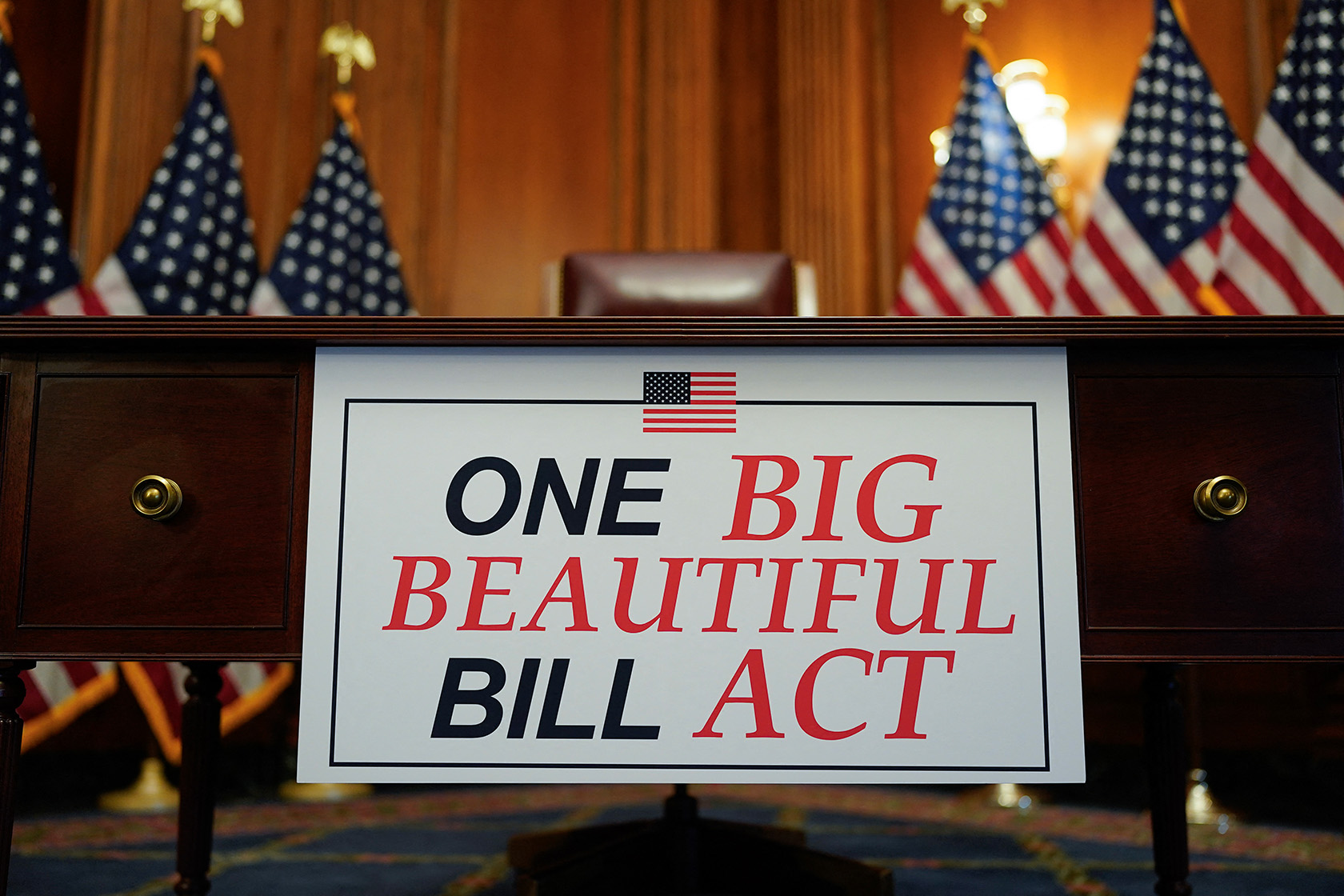
As the Republican budget bill, known as the One Big Beautiful Bill Act, approaches its July 4 deadline set by the White House, legislative maneuvering and public debate surrounding its potential effects have intensified. The bill, which recently passed the House of Representatives, contains provisions anticipated to touch numerous aspects of American financial life, from individual tax burdens and healthcare access to federal spending priorities and the national debt.
However, differing interpretations of the bill’s consequences abound, with competing claims from both Republican and Democratic lawmakers frequently dominating the public discourse. Understanding the potential impact of such comprehensive legislation requires careful examination of the specific proposals and the analyses offered by various governmental and independent bodies.
This article aims to lay out what is known about the anticipated effects of the One Big Beautiful Bill Act, delving into some of the key areas where significant changes are projected and where the rhetoric surrounding the bill’s impact has diverged most sharply from independent assessments.

1. **Debate Over Projected Take-Home Pay Increases**:One area of significant contention surrounds the bill’s projected impact on household finances, specifically take-home pay. Republican proponents have offered optimistic figures, with Sen. Markwayne Mullin stating that an “average household of four is going to bring home pay over $10,000 more a year this year than they did last year.” President Trump offered an even higher figure at a White House event, claiming the bill would immediately “increase take-home pay for the normal family of four by at least $13,000.”
These assertions appear to be drawn from the higher end of estimates produced by the White House’s own Council of Economic Advisers (CEA). The CEA’s analysis of an earlier House version of the bill projected potential increases for a typical family with two children ranging between approximately $7,800 and about $13,300. When the CEA analyzed the subsequent Senate version, this estimated range narrowed slightly, falling between nearly $7,600 and $10,900.
It is critical to note that these CEA estimates were predicated on the assumption that real, inflation-adjusted gross domestic product would grow by more than 4% annually for at least the first four years under the bills. However, the nonpartisan Committee for a Responsible Federal Budget characterized these as “fantasy growth assumptions” that “are many times higher” than projections from other independent analysts. These other modelers have reportedly projected economic growth in the range of 0.1% to 1.3% per year, which would naturally result in a smaller increase in take-home pay for families than the CEA’s more optimistic scenario.

2. **Anticipated Changes to Medicaid Eligibility and Coverage**:The potential impact of the bill on Medicaid, the health insurance program providing coverage to more than 71 million low-income Americans, is another point of significant disagreement between the parties, with analyses indicating substantial changes contrary to some political claims. President Trump asserted at the White House on June 26 that under the bill, “your Medicaid is left alone. It’s left the same.”
However, the program would change for millions of people because of provisions that significantly reduce future Medicaid spending and modify eligibility criteria for the program. These changes involve implementing new work requirements for adults who gained coverage under the Affordable Care Act’s Medicaid expansion beginning in December of 2026, alongside more frequent eligibility checks and disincentives for states to cover unauthorized migrant children, among other provisions. The nonpartisan Congressional Budget Office (CBO) estimated that Medicaid provisions in the House version of the bill would cause 7.8 million people to lose their coverage in 2034, with the majority (5.2 million) expected to lose it due to the work requirements.
For a previous story, health care experts told us that many beneficiaries would likely face challenges navigating the required paperwork to demonstrate eligibility, potentially leading to individuals being dropped from the Medicaid rolls. Furthermore, experts noted that not all individuals losing coverage would fit the description of able-bodied adults refusing to work, as some Republicans have claimed. Meanwhile, some Democrats have reportedly exaggerated the potential coverage losses. For example, Senator Mark Warner, in a June 29 interview on CNN, said, “this bill will kick about 16 million Americans off of health care,” a figure he attributed to “the independent referees, CBO and others.” However, the CBO said that the House version would result in 10.9 million more people becoming uninsured in 2034 (including current Medicaid beneficiaries and people who now get their health insurance through the ACA marketplaces), while the Senate version was estimated to lead to 11.8 million losing health insurance in 2034. The higher figure cited by some Democrats appears to include estimated losses related to the scheduled expiration of ACA premium tax credits in 2025, a matter not directly tied to the bill under consideration.

3. **Conflicting Analyses on the Bill’s Federal Deficit Impact**:Perhaps the most significant point of divergence in how the bill’s effects are characterized lies in its projected impact on the federal deficit. Democratic Senator Amy Klobuchar said the Senate bill will raise federal deficits by $4 trillion, while the White House said it will cut the deficit by $1.4 trillion. This vast difference hinges primarily on how the extension of the 2017 Tax Cuts and Jobs Act, championed by Trump, is factored into the long-term fiscal outlook.
Independent analyses that account for the extension of the 2017 tax cuts project a substantial increase in the national debt. The CBO has said the bill passed by the Senate will add at least $3.3 trillion to the national debt over the next 10 years. The Committee for a Responsible Federal Budget estimated the Senate bill will increase the federal debt by more than $3.9 trillion through 2034. Senator Klobuchar echoed these concerns in a July 1 statement shortly after the bill’s passage in the Senate, stating, “Congressional Republicans betrayed the American people, passing a bill that will raise our debt by $4 trillion.”
Conversely, Senate Republicans have employed a budgetary maneuver to exclude the cost of extending the 2017 tax cuts from the official deficit calculation for the bill. This approach relies on the argument that because the tax cuts have been in effect and are considered “current policy,” their continuation should not be counted as new spending that adds to future deficits. Republican Sen. Bill Hagerty, presiding over the Senate in April, ruled that Sen. Lindsey Graham, the Senate Budget Committee chair, had the sole authority to decide whether extending the 2017 tax cuts officially adds to the deficit. Senator Jeff Merkley, ranking member of the Senate Budget Committee, objected strongly to this practice, stating, “The ability of the chair to create a phony baseline has never been used in reconciliation, not ever.” A letter from Senate Minority Leader Chuck Schumer, Merkley, and Ron Wyden to Republican leadership criticized this “budget fraud,” calling the “current policy baseline” an “unprecedented gimmick” that would “upend budget law, erode the remaining fiscal guardrails in the budget reconciliation process, and result in trillions of dollars more in federal debt,” potentially costing “$37 trillion over 30 years.” Nonpartisan watchdog group Taxpayers for Common Sense also criticized this method in a July 1 statement, describing it as “cooking the books” and “pretending that temporary tax cuts are permanent fixtures” used to “hide trillions in costs from the American people.” Meanwhile, the White House argued in a June 7 memo that extending the cuts is certain and an “honest portrayal” should adjust for this continuation. On its own, excluding the 2017 extension, the White House claimed the bill “reduces the deficit by over $1.4 trillion,” citing net mandatory savings partly offset by increases in one-time spending for border security and tax reductions from policies such as no tax on tips or overtime.

4. **Examining the Distribution of Tax Benefits Under the Bill**:A central point of political debate concerns who would ultimately benefit from the tax provisions within the bill, which includes $4.5 trillion in tax cuts — extending the lower rates passed in 2017 and adding new tax cuts. Democrats have characterized the legislation as providing “tax breaks for billionaires,” arguing that cuts to safety net programs were made in service of aiding the very wealthy. Senate Democratic Leader Chuck Schumer stated this explicitly on the Senate floor on June 28, asking, “Why are they doing all this? We know why. Tax breaks for billionaires.” Democratic Senator Mark Kelly similarly stated on MSNBC that, “This is just so Republicans can give a big tax cut to the wealthiest Americans.”
Republicans, however, frame the bill as a tax cut primarily benefiting “working-and-middle class Americans.” Senator Jim Banks on “Fox News Sunday” on June 29 called the bill “the biggest tax cut in American history for working class families,” and the White House put out a release pushing back against the “myth” that the bill “takes from the poor to give to the rich.” The White House release claimed that “Low-income workers stand to receive the largest percentage reduction in their tax liability” and it delivers “the largest tax cut in history for working-and-middle class Americans.”
Independent analyses generally support the notion that a majority of taxpayers across all income groups would receive some level of tax relief if the 2017 tax cuts are made permanent, as proposed by the bill. However, these analyses also indicate that the benefits skew significantly towards higher-income individuals. The Tax Foundation, analyzing the version of the bill passed by the Senate Finance Committee and accounting for expected economic growth, found that the percentage change in after-tax income increases on average as income rises. Their analysis projected that in 2034, those in the bottom 20% of earners would see a 0.5% increase in after-tax income, while those in the top 20% would see the largest increase at 3.7%. Similarly, the Urban-Brookings Tax Policy Center’s analysis of the Senate Budget Committee version concluded that “Average tax cuts are generally larger as a percentage of after-tax income for higher income households than for lower income households,” and noted that “nearly 60 percent of the tax benefits would go to those in the top quintile (with incomes of about $217,000 or more).” The Penn Wharton Budget Model, factoring in lifetime income and the effects of cuts to Medicaid and food assistance (SNAP), found that working-age households in the bottom income quintile experienced the largest lifetime losses, averaging $27,500, primarily due to a reduced social safety net and lower wages associated with a lower capital stock. In contrast, working-age households in the top income quintile generally benefited from lower taxes, gaining an average of more than $65,000. The model also projected that all future generations would experience lifetime losses under the bill, ranging from $5,700 for high-income households to $22,000 for low-income households, with losses for lower-income groups tied to a reduced social safety net and lower wages, and losses for top-income groups linked entirely to lower wages.

5. **Proposed Modifications to Taxation of Social Security Benefits**:The bill includes provisions related to the taxation of Social Security benefits, an area where President Trump has made a distinct claim. In a Fox News interview on June 29, Trump again claimed—as he has repeatedly—that if the bill passes there would be “no tax on Social Security.” This assertion requires clarification, as the reality is more nuanced, and not everyone would be exempt.
Under both the House and Senate versions of the plan, fewer seniors would indeed pay taxes on their Social Security benefits compared to current law, but the tax would not be eliminated entirely for everyone. The Senate version proposes adding a $6,000 tax deduction for individuals age 65 and older, and $12,000 for married seniors, beginning in 2025 and through 2028. The House version offers a slightly lower $4,000 deduction during the same period through 2028.
According to the White House’s Council of Economic Advisers (CEA), a significant majority of seniors aged 65 and over who receive Social Security income already receive exemptions and deductions that exceed their taxable Social Security income, meaning most currently do not pay taxes on these benefits. The CEA projects that under the more generous Senate proposal, an additional 14.2 million seniors would see their exemptions and deductions surpass their taxable income, so that, in effect, 88% of seniors would not pay any taxes on their Social Security income. However, these senior deductions would start to decline for individuals with incomes of more than $75,000 and couples with incomes of more than $150,000, and would disappear entirely for individuals making over $175,000. Therefore, while the bill would dramatically reduce the number of seniors paying taxes on Social Security benefits, the CEA’s own analysis indicates that more than 7 million seniors with higher incomes would still face this tax.

6. **Trump’s Unfounded 68% Tax Increase Warning**:President Trump has repeatedly issued a stark warning, claiming that if the One Big Beautiful Bill doesn’t pass, Americans face a “whopping 68% Tax increase.” He has made this assertion since April, reiterating it as recently as June 29 in a Fox News interview and on June 27, stating it comes from not “ending taxes on tips, overtime, and Social Security” as proposed in the bill, along with the effect of not extending certain expiring provisions from the 2017 Tax Cuts and Jobs Act.
However, multiple analyses, including those from nonpartisan tax policy experts, do not support a figure anywhere near 68%. Joseph Rosenberg, a senior fellow at the Urban Institute’s Urban-Brookings Tax Policy Center, stated that “By far the largest part of the bill is extending the expiring tax cuts,” referring to the 2017 provisions. He explicitly noted that adding in the proposed changes to taxes on tips, overtime, and Social Security would not “close the gap” to reach a 68% rise in taxes.
Rosenberg pointed to estimates released by the Joint Committee on Taxation (JCT) on July 1, which provide a different perspective on the magnitude of potential tax changes. According to the JCT, the total change resulting from new tax-cut provisions *within* the bill approved by the Senate amounts to a 3.5% change. When including the extension of the 2017 tax cuts, the total projected change is 10.7%. This figure represents a significant increase compared to current policy should the 2017 cuts expire, but it remains a “far cry from the 68% claimed by Trump,” as the context highlights. The White House, when asked for an explanation of how the 68% figure was calculated, reportedly did not provide one, although spokeswoman Abigail Jackson stated the talking point reflected the impact of not ending taxes on tips, overtime, and Social Security in addition to the 2017 extension.


:max_bytes(150000):strip_icc():focal(749x0:751x2)/kirstie-alley-dies-20050615_09-b191dad23e0e443488d39ad92d37fd8c.jpg)

